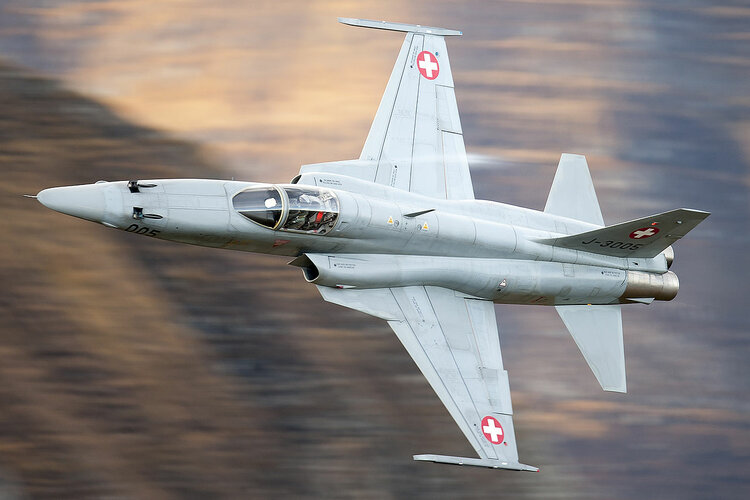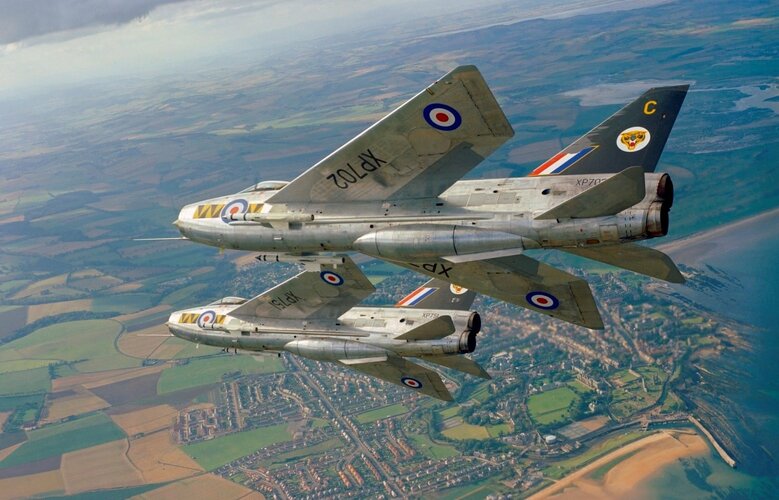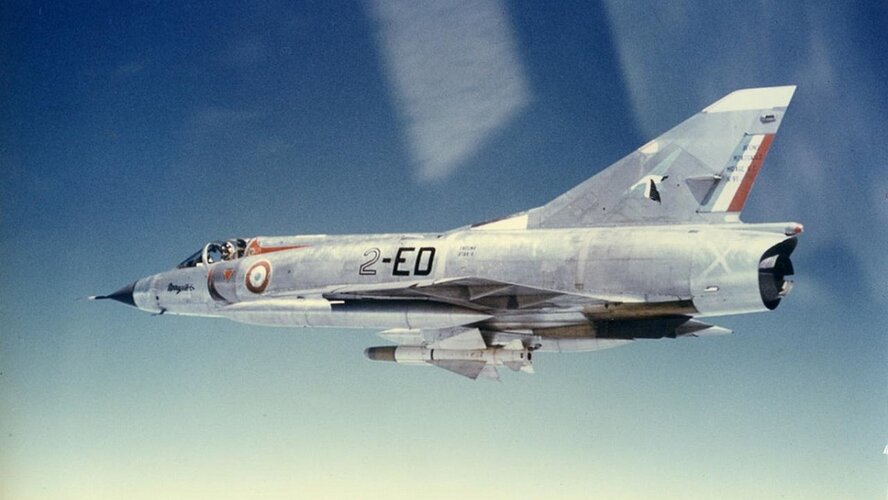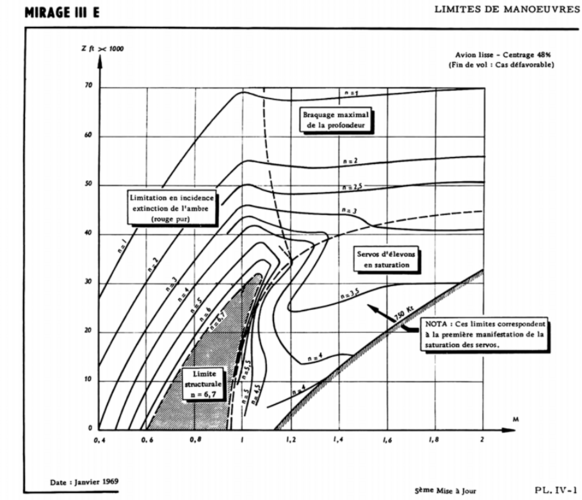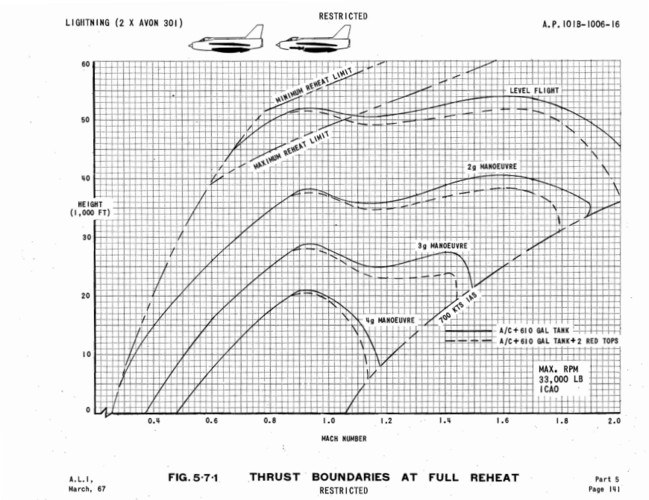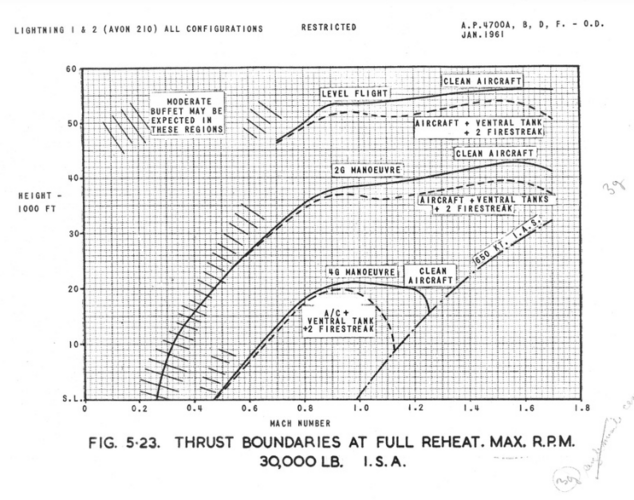You are using an out of date browser. It may not display this or other websites correctly.
You should upgrade or use an alternative browser.
You should upgrade or use an alternative browser.
Fighters of the 60s-70s: F-5 vs English Electric Lightning vs Mirage III
- Thread starter Ronny
- Start date
- Joined
- 21 May 2006
- Messages
- 3,003
- Reaction score
- 2,284
Just to clarify, if I may Ronny, which derivative of the Northrop F-5 and English Electric Lightning are you implying? I ask because you've clearly denoted the 'C' variant of the Dassault Mirage III.
Regards
Pioneer
Regards
Pioneer
F-5E tiger II, same as the version that was used by the South Vietnam basicallyJust to clarify, if I may Ronny, which derivative of the Northrop F-5 and English Electric Lightning are you implying? I ask because you've clearly denoted the 'C' variant of the Dassault Mirage III.
Regards
Pioneer
and English Lightning F.6
-F-5 for cost and maintenance - top notch, nothing beats it there. Also agile in air combat. In fact at Top Gun it bet the hell out of Phantoms, Eagles and Tomcats in close combat - a) by being so hard to spot visually and - b) by being agile when the fight started.
-Lightning for absolute performance, notably as interceptor - no question about this. Went as high as 88 000 feet in jet power alone; no need for the Mirage SEPR conformal rocket packet. Excellent radar, good missiles.
-Mirage IIIC as an "honest to god" "in-between" the two
- Cheap and (relatively) nimble like a F-5
- Radar, missiles & Mach 2 like the Lightning and unlike the F-5A/E
- Air-to-ground: more payload than a F-5, more "mutirole" than early Lightnings.
Some OTL facts
- Israel bought Mirage III-C (not III-E, hence not for attack) but put bomb racks on them and (greatly helped by a very clear weather), demolished Arab air force. This drove them toward Mirage V, then Nesher.
- Saudia Arabia and another Gulf state I forgot the name (one of the UAEs !) bought Lightnings and, from F3 / F6 onwards, it forced GB to develop that aircraft A2G capability
- Iran used its F-5s enormously during the war with Iraq
-against MiG-21: perfect
-against MiG-23: left behind in the dust in raw acceleration
-against MiG-25: same as above obviously, except if they went low and slow, there one F-5 managed to get a victory
- the F-5E only had IR Sidewinders
- the Lightning had Red Tops (IR medium range)
- the Mirage had Sidewinders & Magic 1 + R-530 medium range SARH
(usually 3 missiles: one R-530 on the centerline and two IR on wing pylons. none of these missiles being very reliable nor efficient nor useful).
-Lightning for absolute performance, notably as interceptor - no question about this. Went as high as 88 000 feet in jet power alone; no need for the Mirage SEPR conformal rocket packet. Excellent radar, good missiles.
-Mirage IIIC as an "honest to god" "in-between" the two
- Cheap and (relatively) nimble like a F-5
- Radar, missiles & Mach 2 like the Lightning and unlike the F-5A/E
- Air-to-ground: more payload than a F-5, more "mutirole" than early Lightnings.
Some OTL facts
- Israel bought Mirage III-C (not III-E, hence not for attack) but put bomb racks on them and (greatly helped by a very clear weather), demolished Arab air force. This drove them toward Mirage V, then Nesher.
- Saudia Arabia and another Gulf state I forgot the name (one of the UAEs !) bought Lightnings and, from F3 / F6 onwards, it forced GB to develop that aircraft A2G capability
- Iran used its F-5s enormously during the war with Iraq
-against MiG-21: perfect
-against MiG-23: left behind in the dust in raw acceleration
-against MiG-25: same as above obviously, except if they went low and slow, there one F-5 managed to get a victory
- the F-5E only had IR Sidewinders
- the Lightning had Red Tops (IR medium range)
- the Mirage had Sidewinders & Magic 1 + R-530 medium range SARH
(usually 3 missiles: one R-530 on the centerline and two IR on wing pylons. none of these missiles being very reliable nor efficient nor useful).
- Joined
- 19 July 2016
- Messages
- 4,287
- Reaction score
- 3,466
The questions, "What type of fighter"? And, "What do you call a fighter"? Come to mind, the Lightning was an interceptor.
kaiserd
I really should change my personal text
- Joined
- 25 October 2013
- Messages
- 1,657
- Reaction score
- 1,726
You are not comparing like to like.
The Mirage IIIC first flew in 1960.
The F-5E first flew in 1972 ( more than 5 years after the later Mirage F1 first flew).
The Mirage III was almost as good/ high performance as a Lightening but much cheaper and not nearly as much as a maintenance hand full.
The F-5A was clearly inferior to both but was even cheaper and even more maintenance friendly.
The F-5E and Mirage F-1s were later better aircraft and clearly in different leagues as dogfighters/ tactical fighters (though that is perhaps a bit unfair in that the Mirage III that was clearly the best all rounder of the earlier 3 designs).
The Mirage IIIC first flew in 1960.
The F-5E first flew in 1972 ( more than 5 years after the later Mirage F1 first flew).
The Mirage III was almost as good/ high performance as a Lightening but much cheaper and not nearly as much as a maintenance hand full.
The F-5A was clearly inferior to both but was even cheaper and even more maintenance friendly.
The F-5E and Mirage F-1s were later better aircraft and clearly in different leagues as dogfighters/ tactical fighters (though that is perhaps a bit unfair in that the Mirage III that was clearly the best all rounder of the earlier 3 designs).
Vanessa1402
ACCESS: Confidential
- Joined
- 10 April 2021
- Messages
- 136
- Reaction score
- 67
BVR: clearly Mirage because only it can carry long range missile
WVR: Electric lighting because it can boom and zoom with acceleration on pair with F-16
WVR: Electric lighting because it can boom and zoom with acceleration on pair with F-16
I know there probably a little bit of time between them, but I think the different was not enough to make later one superior to the former.You are not comparing like to like.
The Mirage IIIC first flew in 1960.
The F-5E first flew in 1972 ( more than 5 years after the later Mirage F1 first flew).
The Mirage III was almost as good/ high performance as a Lightening but much cheaper and not nearly as much as a maintenance hand full.
The F-5A was clearly inferior to both but was even cheaper and even more maintenance friendly.
The F-5E and Mirage F-1s were later better aircraft and clearly in different leagues as dogfighters/ tactical fighters (though that is perhaps a bit unfair in that the Mirage III that was clearly the best all rounder of the earlier 3 designs).
For example: F-5E came much later, but its acceleration still much inferior to Electric Lightning F6. Their radar still roughly the same
- Joined
- 27 December 2005
- Messages
- 17,753
- Reaction score
- 26,468
It should be F-5A in this comparison not F-5E. F-5E is much later and not a fair comparison.
Mirage III is probably the winner for me. Not sure its R530 AAMs ever had successful action though.
Mirage III is probably the winner for me. Not sure its R530 AAMs ever had successful action though.
I think the dynamic doesn't change a lot when changed from F-5A to F-5E, at least when comparing to Electric Lightning F6It should be F-5A in this comparison not F-5E. F-5E is much later and not a fair comparison.
Mirage III is probably the winner for me. Not sure its R530 AAMs ever had successful action though.
The electric lightning F-6 still accelerate much faster than the F-5E
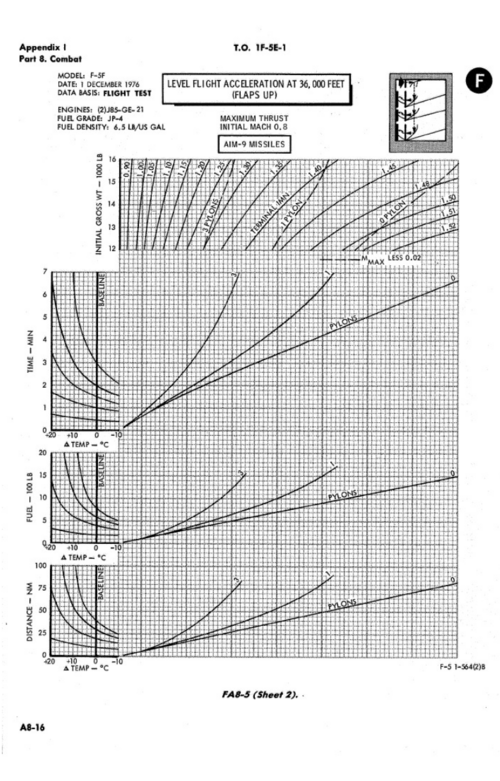
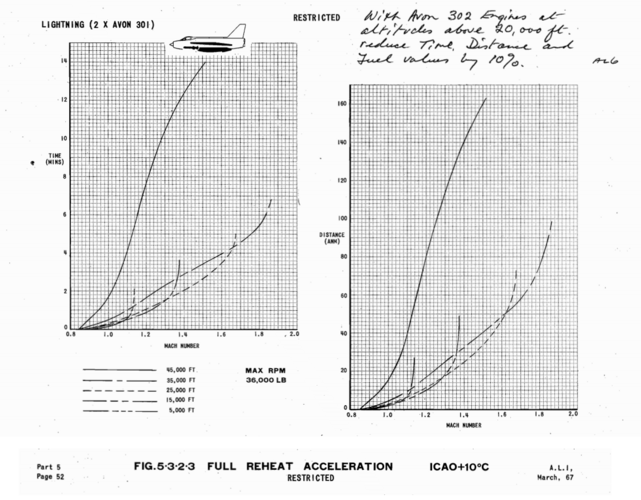
By contrast, F-5E turn better than the lightning F-6
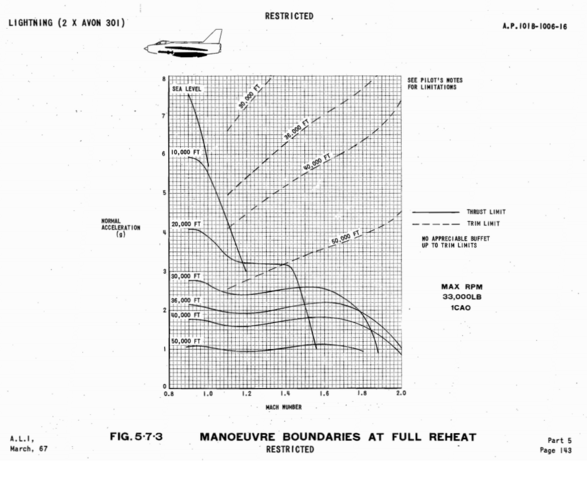
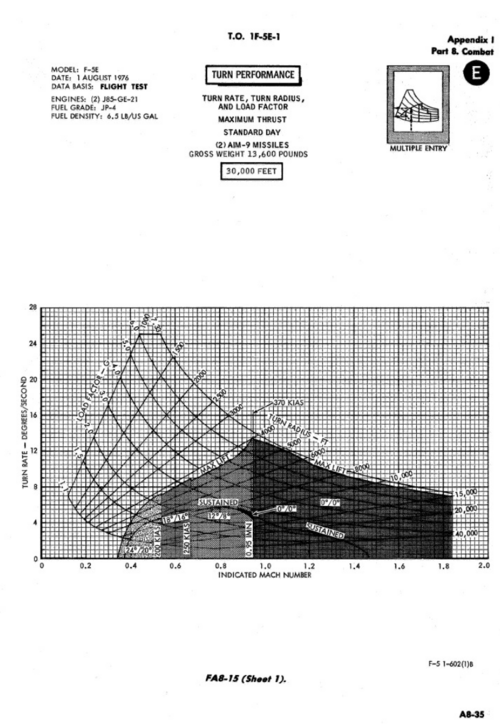
- Joined
- 27 September 2006
- Messages
- 6,418
- Reaction score
- 6,826
Interesting topic as I would not have considered them analogues.
The Mirage III in its various models (Inc V) is a multi role fighter-bomber. Its main customers France and Israel used it as everything from a nuclear delivery (with An52) to a recce bird.
The Lightning was tailored to give the RAF an interceptor with two heat seeking missiles. It got sold only to Saudi Arabia and Kuwait for political reasons. No-one else bought it.
The F5 cropped up everywhere from NATO (Canada, Netherlands and Norway) to South Vietnam. It was cheap and cheerful. Can't recall it winning any real dogfights but am happy to be corrected.
Only the Mirage got widespread combat use.
The Mirage III in its various models (Inc V) is a multi role fighter-bomber. Its main customers France and Israel used it as everything from a nuclear delivery (with An52) to a recce bird.
The Lightning was tailored to give the RAF an interceptor with two heat seeking missiles. It got sold only to Saudi Arabia and Kuwait for political reasons. No-one else bought it.
The F5 cropped up everywhere from NATO (Canada, Netherlands and Norway) to South Vietnam. It was cheap and cheerful. Can't recall it winning any real dogfights but am happy to be corrected.
Only the Mirage got widespread combat use.
D
Deleted member 2278
Guest
Echoing somewhat profusely but I definitely wouldn't consider them analogues. Lightning was a supersonic research aircraft with interceptor capability essentially bootstrapped onto it in an interim capacity. That it was still flying in the same role well into the eighties does not negate it's compromised origins and subsequent quasi-criminal underinvestment. That it was exported does not negate that it was very much a niche aircraft, useful in only a narrow set of circumstances not readily found elsewhere beyond home shores.
It was unique, brilliant and excelled in many arenas but I don't consider it a "fair test" to make comparisons to other designs. Maybe the F-104 but even then eehhhh [wobbles hand].
The F-5 is a generation later, the Mirage III contemporary but a different animal. Undoubtedly the export success. Which is the best? Any of the three depending on the aspect selected most important.
It was unique, brilliant and excelled in many arenas but I don't consider it a "fair test" to make comparisons to other designs. Maybe the F-104 but even then eehhhh [wobbles hand].
The F-5 is a generation later, the Mirage III contemporary but a different animal. Undoubtedly the export success. Which is the best? Any of the three depending on the aspect selected most important.
- Joined
- 27 September 2006
- Messages
- 6,418
- Reaction score
- 6,826
There are numerous air combat simulations these days I wonder if any of them would allow a dogfight between standard versions of each plane?
The F5 would seem to be the most agile and as the smallest perhaps too hard for a Firestreak or R530 to down. But its two early mark Sidewinders might have a job hitting a Lightning or a well flown Mirage.
The Lightning can clear off or up pretty drastically. But is Firestreaks are probably not going to lock on to an F5 but perhaps to a Mirage.
Take the missiles out of the game and just go for cannon armed versions.
The F5 would seem to be the most agile and as the smallest perhaps too hard for a Firestreak or R530 to down. But its two early mark Sidewinders might have a job hitting a Lightning or a well flown Mirage.
The Lightning can clear off or up pretty drastically. But is Firestreaks are probably not going to lock on to an F5 but perhaps to a Mirage.
Take the missiles out of the game and just go for cannon armed versions.
_Del_
I really should change my personal text... Or not.
- Joined
- 4 January 2012
- Messages
- 1,315
- Reaction score
- 1,812
The F5 cropped up everywhere... Can't recall it winning any real dogfights but am happy to be corrected.
The F-5 did rather well In air combat with Iran and Ethiopia gaining kills against the Iraqi and Somali MiGs respectively. Maybe Vietnam and others, as well, but the first two were rather pleased with their F-5's combat performance. Both were impressed enough to keep the type in service well after US support dried up.
Ethiopia kept their fleet active after US supplies stopped when they became a Soviet client state by inheriting Vietnam's F-5's, even though MiGs were available and supplied to Ethiopia by the Soviets.
Iran is obviously still flying and refurbishing them despite having newer fighters available.
Neither probably happens (certainly not for this long, in case of the Iranian aircraft) if not for their combat performances.
- Joined
- 15 July 2007
- Messages
- 4,889
- Reaction score
- 4,554
Wouldn't the F5 be better to compare with the likes of the Gnat, Marut and Etendard?
While Mirage III is better compared to Starfighter or MiG21?
Lightning sits in a rather specialised niche. Delta Dart, Draken and Su-21 might be comparable?
While Mirage III is better compared to Starfighter or MiG21?
Lightning sits in a rather specialised niche. Delta Dart, Draken and Su-21 might be comparable?
I tried to find the Mirage III manual on
But apparently the website is down?, anyone else have the same issue?
But apparently the website is down?, anyone else have the same issue?
I only mean the F-5E around the 60s-70s period, otherwise it would be too unfair.F-5E, you can put Python 4s and AIM-120s for air to air and Mavericks for air to ground if Brazil is to be believed.
kaiserd
I really should change my personal text
- Joined
- 25 October 2013
- Messages
- 1,657
- Reaction score
- 1,726
As mentioned above the F-5E first flew in 1972. So only first entered service in 1975.I only mean the F-5E around the 60s-70s period, otherwise it would be too unfair.F-5E, you can put Python 4s and AIM-120s for air to air and Mavericks for air to ground if Brazil is to be believed.
So only in existence for approx 1/4 of that period. And more than a decade after the other aircraft mentioned above so not really a contemporary aircraft.
Last edited:
D
Deleted member 2278
Guest
F-5E, you can put Python 4s and AIM-120s for air to air and Mavericks for air to ground if Brazil is to be believed.
Yeah if that's game, I'm putting Meteor and SPEAR 3 on the Lightning then. I win the thread!
More seriously though, Lightning vs Yak-28P would be an interesting comparison.
F-2
ACCESS: Top Secret
- Joined
- 22 May 2020
- Messages
- 887
- Reaction score
- 1,725
Besides being a silly smart ass, I only said that because Brazil’s F-5s really DO carry that armament.F-5E, you can put Python 4s and AIM-120s for air to air and Mavericks for air to ground if Brazil is to be believed.
Yeah if that's game, I'm putting Meteor and SPEAR 3 on the Lightning then. I win the thread!
More seriously though, Lightning vs Yak-28P would be an interesting comparison.
D
Deleted member 2278
Guest
Yes, fascinating (and quite well known  ) but well outside the timeframe in question. You can read my comment as "let's keep this 60s-70s, shall we?" with a certain degree of sarcasm. Your anachronism permits others. Sauce for the goose is sauce for the gander afterall. I took that anachronism to it's furthest extreme to demonstrate it's futility. No charge.
) but well outside the timeframe in question. You can read my comment as "let's keep this 60s-70s, shall we?" with a certain degree of sarcasm. Your anachronism permits others. Sauce for the goose is sauce for the gander afterall. I took that anachronism to it's furthest extreme to demonstrate it's futility. No charge.
Last edited by a moderator:
I know the F-5E flew later than English electric lightning F-6 and Mirage III, however, the different between them was not enough to change the dynamic. For example: F-5A sustain turn better than English electric lightning F-6 at subsonic speed, at supersonic speed, the situation is opposite and F-5A accelerate much slower. When we changed from F-5A to F-5E, then the comparison is still exactly the same. F-5E turn better at subsonic speed but worse in supersonic and it still accelerate slower than the F-6As mentioned above the F-5E first flew in 1972. So only first entered service in 1975.I only mean the F-5E around the 60s-70s period, otherwise it would be too unfair.F-5E, you can put Python 4s and AIM-120s for air to air and Mavericks for air to ground if Brazil is to be believed.
So only in existence for approx 1/4 of that period. And more than a decade after the other aircraft mentioned above so not really a contemporary aircraft.
Last edited:
I finally found proper charts to compare the three aircraft. Turn out, Mirage III is the one with the worse turning capability at subsonic regimeIt should be F-5A in this comparison not F-5E. F-5E is much later and not a fair comparison.
Mirage III is probably the winner for me. Not sure its R530 AAMs ever had successful action though.
In term of sustained turn rate:
Altitude: 25000 feet, Speed: Mach 0.8
Mirage III can sustain 3G
F-5A can sustain 3.5G (F-5E can do even better)
English Electric Lightning F-6 can sustain 3G
Altitude: 25000 feet, Speed: Mach 0.9
Mirage III can sustain 3.5G
F-5A can sustain 3.9G (F-5E can do even better)
English Electric Lightning F-6 can sustain 3.5G
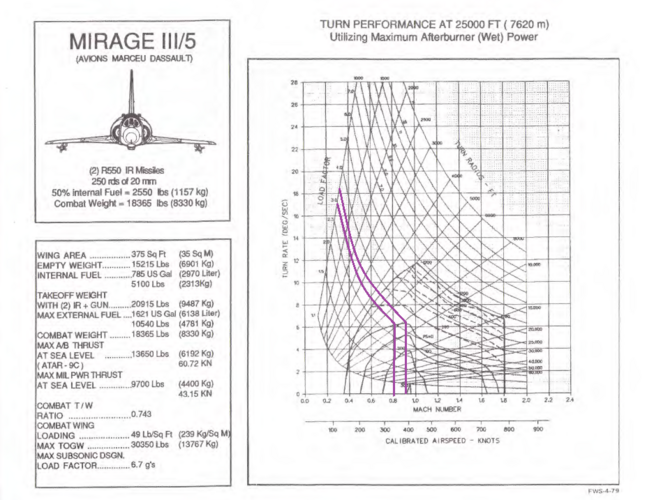
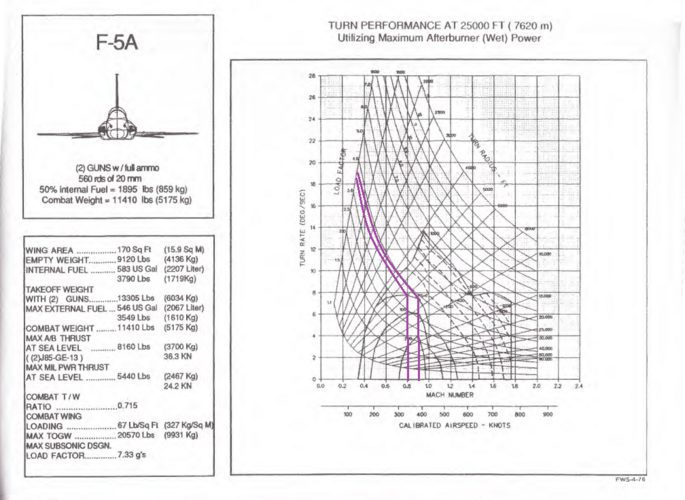
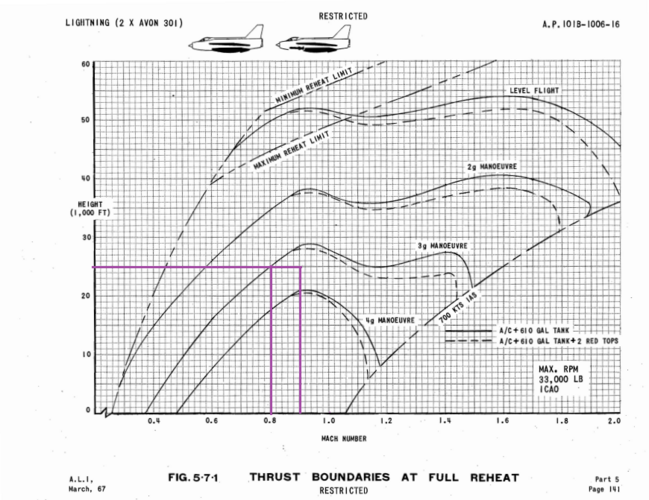
At 15000 feet, Mach 0.74
Mirage III can sustain 3.9 G
F-5E can sustain 4.2 G
English Electric Lightning F6 can sustain 4 G
At 15000 feet, Mach 1.08
Mirage III can sustain 3.9 G
F-5E can sustain 2.5 G
English Electric Lightning F-6 can sustain 4 G
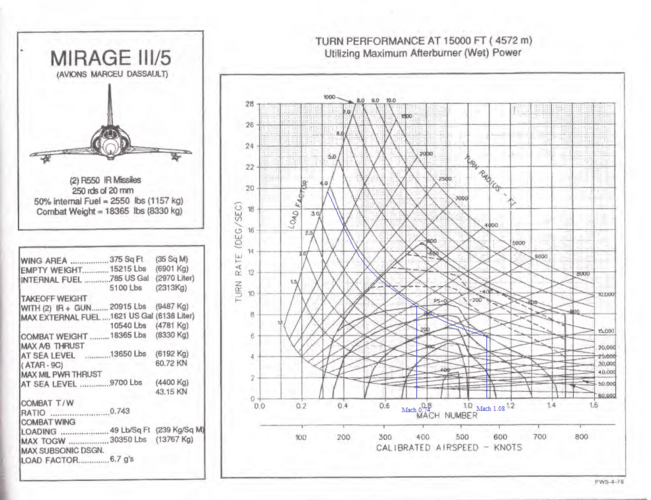
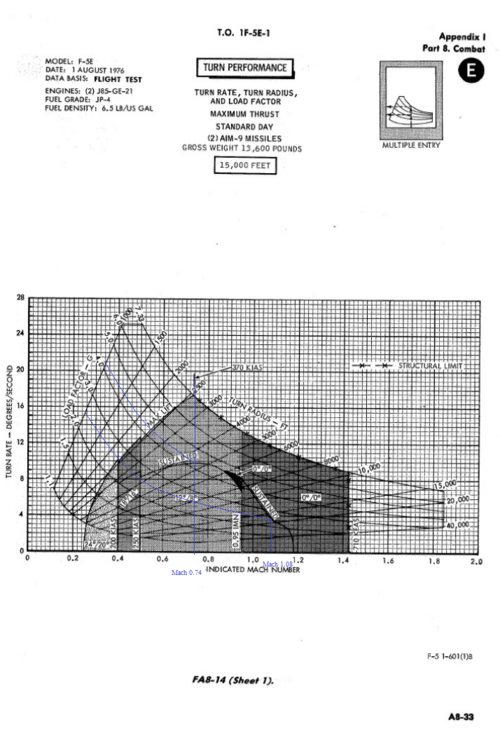
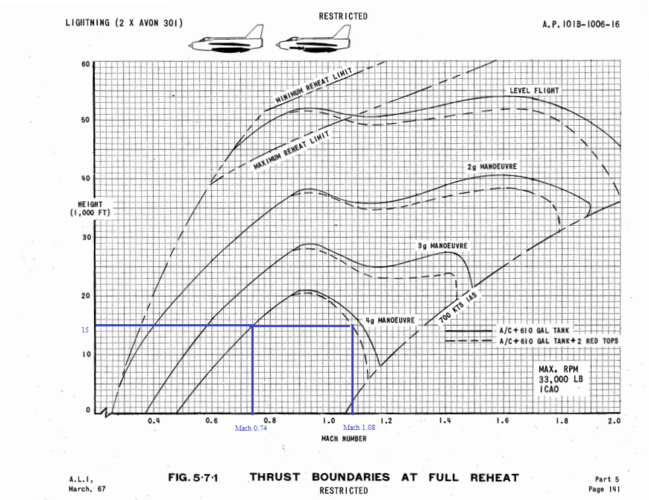
Last edited:
What suprise me the most is how good can the English Electric Lightning F6 turn, it suprisinhly nimble despite the extremely high swept wing and extremely high wing loading.Yeah sure, the delta was a giant airbrake. Without FBW, it was hopeless. Then again, it doesn't seem to have bothered ISraeli pilots against (nimble) MiGs, including at low level, low speeds.
kaiserd
I really should change my personal text
- Joined
- 25 October 2013
- Messages
- 1,657
- Reaction score
- 1,726
I disagree. It fundamentally changes the comparison.I know the F-5E flew later than English electric lightning F-6 and Mirage III, however, the different between them was not enough to change the dynamic. For example: F-5A sustain turn better than English electric lightning F-6 at subsonic speed, at supersonic speed, the situation is opposite and F-5A accelerate much slower. When we changed from F-5A to F-5E, then the comparison is still exactly the same. F-5E turn better at subsonic speed but worse in supersonic and it still accelerate slower than the F-6As mentioned above the F-5E first flew in 1972. So only first entered service in 1975.I only mean the F-5E around the 60s-70s period, otherwise it would be too unfair.F-5E, you can put Python 4s and AIM-120s for air to air and Mavericks for air to ground if Brazil is to be believed.
So only in existence for approx 1/4 of that period. And more than a decade after the other aircraft mentioned above so not really a contemporary aircraft.
The F-5E may not out accelerate or out climb a Lightening F.6 but it more than matches it’s armament (later all aspect AIM-9s out class the 15 year older UK equivalents, unsurprisingly) and is otherwise quite superior as a dogfighter.
Similarly the F-5E narrows any areas where a Mirage III may have an advantage and massive builds on areas of advantage versus a F-5A.
Its like pretending that the Mirage F1 or 2000 are the same aircraft as the Mirage III.
And with respect the Lightening was not known as a particularly agile dogfighter, even in it’s day.
And the chances of a true supersonic dogfight involving any combination of 2 of these 3 aircraft are close to zero.
D
Deleted member 2278
Guest
Thunder & Lightnings - English Electric Lightning - Memories
Cold War British military aircraft, including history, surviving airframes, profile drawings, photos, walkarounds, links, references. Also viewing guides for UK airfields and the Test Flying Memorial
"The overall impression was that both aircraft had very similar performance and handling characteristics, both were a joy to fly. Considering the age difference, the Lightning's performance was totally outstanding when introduced into service, and when it finally bowed out, it could still out-climb most of its successors. Its initial rate of climb was 50,000 ft per minute. The Mirage IIIE climbed initially at 30,000 ft per minute; the Phantom F-4M managed 32,000 ft per minute; the MiG-21 could only manage 36,090 ft per minute; the F-16A's initial rate was 40,000 ft per minute, and the Tornado F.3's 43,000 ft per minute. So the Lightning reigned supreme. Only later was it surpassed; the F-15 Eagle, and the MiG-25 both have initial climb rates as good or better. The Lightning's time to FL 360 in re-heat was 2.5 minutes, in this respect the Eagle produced a similar figure, though this could vary depending upon its configuration."
Hmmm......
red admiral
ACCESS: Top Secret
- Joined
- 16 September 2006
- Messages
- 1,811
- Reaction score
- 2,392
Lightning - stay fast and use superior SEP and STR to boom and zoom, especially using vertical. Might be able to rapidly extend out of SRAAM range. On the other hand - how effective are Firestreak or Red Top against manoeuvring fighters? Getting a guns kill with limited ammo seems challenging... So maybe high survivability but limited lethality
F-5 - Force low and slow as much as possible to use ITR and subsonic STR advantages. And probably superior vision? Both guns and AIM-9 definitely work. But difficult / impossible to actually force the other types to fight in this area due to inferior altitude and speed envelope
Mirage III - sort of like the Lighting but with inferior air vehicle performance but working SRAAMs. Difficult to see the R.530 being much of a factor against manoeuvring fighters
So basically when well flown I think it looks pretty difficult for any of them to actually kill the others
F-5 - Force low and slow as much as possible to use ITR and subsonic STR advantages. And probably superior vision? Both guns and AIM-9 definitely work. But difficult / impossible to actually force the other types to fight in this area due to inferior altitude and speed envelope
Mirage III - sort of like the Lighting but with inferior air vehicle performance but working SRAAMs. Difficult to see the R.530 being much of a factor against manoeuvring fighters
So basically when well flown I think it looks pretty difficult for any of them to actually kill the others
The harsh truth is that before Falklands (as tragically shown in Vietnam) AAMs were unuseful.
The Israelis (here we go again !) got 99% of their 300 and counting Mirage kills 1966-1974 with guns, guns, guns, and more guns.
The usual pitfalls of missiles
- IR seekers went chasing the wrong IR sources
- SARH had I.D issues and wasn't very reliable overall
The turning point for Sidewinder was AIM-9L in the Falklands.
In the case of the Sparrow: the -F and -M variants, Skyflash and Aspide.
AIM-7 earlier variants, the - C/D/E - were rather hopeless.
In the case of France: R-530 and Magic 1 were not very good. Super 530F/D and Magic 2 got much better.
The Israelis (here we go again !) got 99% of their 300 and counting Mirage kills 1966-1974 with guns, guns, guns, and more guns.
The usual pitfalls of missiles
- IR seekers went chasing the wrong IR sources
- SARH had I.D issues and wasn't very reliable overall
The turning point for Sidewinder was AIM-9L in the Falklands.
In the case of the Sparrow: the -F and -M variants, Skyflash and Aspide.
AIM-7 earlier variants, the - C/D/E - were rather hopeless.
In the case of France: R-530 and Magic 1 were not very good. Super 530F/D and Magic 2 got much better.
_Del_
I really should change my personal text... Or not.
- Joined
- 4 January 2012
- Messages
- 1,315
- Reaction score
- 1,812
Israelis got about a third of their kills with missiles by the Yom Kippur War -- mostly the AIM-9D, with some G's delivered late. You're also overlooking the fact that even a missile which misses a substantial percentage of the time like the Great White Hope causes the MiG to evade-- which wrecks havoc on formation discipline, energy management, situational awareness, etc -- all of which contribute to circumstances making those gun kills easier to come by.
As a very general truism, I'd expect fights to start fast and high and get lower and slower as the engagement drags on (unintentional pun). I rather like the chances for the F-5 family here, but as someone noted above, it's any body's game if you can play to your strengths and define the engagement.
As a very general truism, I'd expect fights to start fast and high and get lower and slower as the engagement drags on (unintentional pun). I rather like the chances for the F-5 family here, but as someone noted above, it's any body's game if you can play to your strengths and define the engagement.
- Joined
- 3 June 2011
- Messages
- 18,348
- Reaction score
- 12,264
Strange given the Streak Eagle got to 36k (12km) in 55 seconds. I wouldn't think an Eagle in service would be THAT much slower. (Yes, I know the Streak Eagle was stripped down.)Thunder & Lightnings - English Electric Lightning - Memories
Cold War British military aircraft, including history, surviving airframes, profile drawings, photos, walkarounds, links, references. Also viewing guides for UK airfields and the Test Flying Memorialwww.thunder-and-lightnings.co.uk
The Lightning's time to FL 360 in re-heat was 2.5 minutes, in this respect the Eagle produced a similar figure, though this could vary depending upon its configuration."
Hmmm......
I decided to add some maneuver data of the famous F-4E in the comparison
At 15000 feet, Mach 0.74
F-4E can sustain 4.4 G
Mirage III can sustain 3.9 G
F-5E can sustain 4.2 G
English Electric Lightning F6 can sustain 4 G
At 15000 feet, Mach 1.08
F-4E can sustain 4G
Mirage III can sustain 3.9 G
F-5E can sustain 2.5 G
English Electric Lightning F-6 can sustain 4 G

Altitude: 25000 feet, Speed: Mach 0.8
F-4E can sustain 3.3G
Mirage III can sustain 3G
F-5A can sustain 3.5G (F-5E can do even better)
English Electric Lightning F-6 can sustain 3G
Altitude: 25000 feet, Speed: Mach 0.9
F-4E can sustain 3.7G
Mirage III can sustain 3.5G
F-5A can sustain 3.9G (F-5E can do even better)
English Electric Lightning F-6 can sustain 3.5G

At 15000 feet, Mach 0.74
F-4E can sustain 4.4 G
Mirage III can sustain 3.9 G
F-5E can sustain 4.2 G
English Electric Lightning F6 can sustain 4 G
At 15000 feet, Mach 1.08
F-4E can sustain 4G
Mirage III can sustain 3.9 G
F-5E can sustain 2.5 G
English Electric Lightning F-6 can sustain 4 G
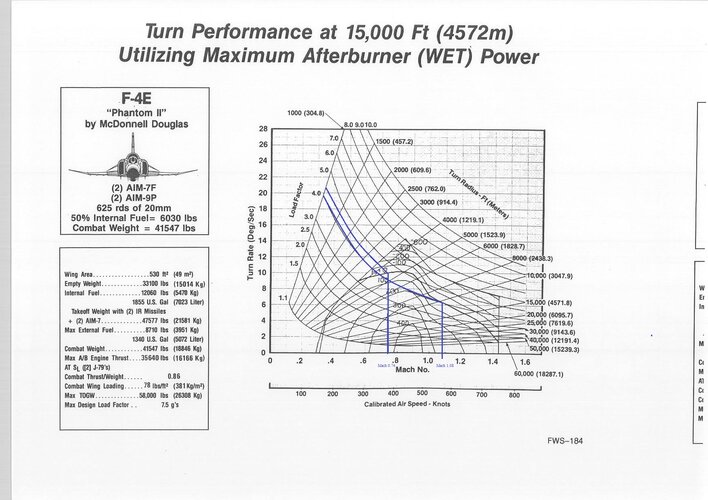
Altitude: 25000 feet, Speed: Mach 0.8
F-4E can sustain 3.3G
Mirage III can sustain 3G
F-5A can sustain 3.5G (F-5E can do even better)
English Electric Lightning F-6 can sustain 3G
Altitude: 25000 feet, Speed: Mach 0.9
F-4E can sustain 3.7G
Mirage III can sustain 3.5G
F-5A can sustain 3.9G (F-5E can do even better)
English Electric Lightning F-6 can sustain 3.5G
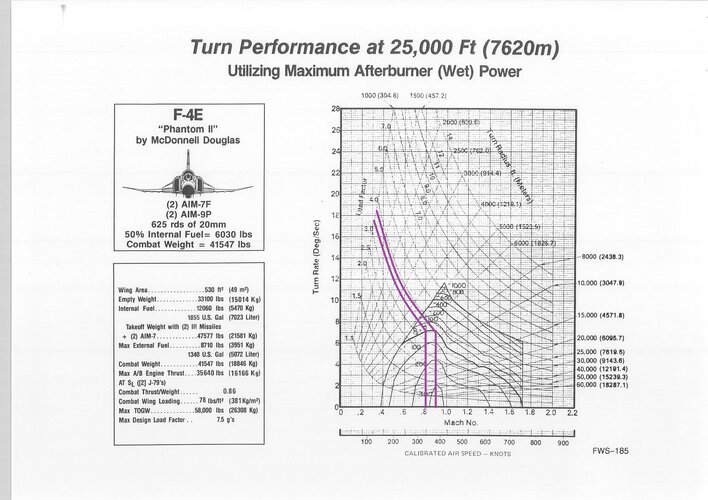
If I recall correctly , F-5E also didn't have all aspect IR missile, while the Red top missile on Lightning F6 is an all aspect missile. So technically speaking I think Lightning F-6 still got superior weapon (of course not counting the much later F-5E with AIM-9L, Python, AIM-120)I disagree. It fundamentally changes the comparison.
The F-5E may not out accelerate or out climb a Lightening F.6 but it more than matches it’s armament (later all aspect AIM-9s out class the 15 year older UK equivalents, unsurprisingly) and is otherwise quite superior as a dogfighter.
I don't have Mirage F-1 chart so I can't say for certain how good it is compared to Mirage III, but I can see the Mirage 2000 changed the comparison completelySimilarly the F-5E narrows any areas where a Mirage III may have an advantage and massive builds on areas of advantage versus a F-5A.
Its like pretending that the Mirage F1 or 2000 are the same aircraft as the Mirage III.
For example:
At 15000 ft Mach 0.74
Mirage 2000 can sustain 5.3G
At 15000 ft Mach 1.08,
Mirage 2000 can sustain 5.1G
That mean if we replaced the Mirage III with Mirage 2000, it changed from being the aircraft with the worst sustain turn rate in the list, to the one with the best sustain turn rate in the list.
Furthermore, Mirage III structure G limit is at 6.3G, F-5E structure G limit is 7.33G, Lightning F6 structure limit is 8G. In other words, at low altitude, where the air is thick, Mirage III is also the one with the worst instantaneous turn rate. By contrast, Mirage 2000 structure G limit is at 9G and it can turn even better than F-5E
At 15k ft, the maximum instantaneous turn rate of
F-5E is 17.8 degrees/second
F-4E is 14.1 degrees/second
Mirage III is 15 degrees/second
Mirage 2000 is 23.8 degrees/second
At 15k ft, the maximum sustain turn rate of
F-5E is 9.9 degrees/second
F-4E is 10.1 degrees/second
Mirage III is 9 degrees/second
Mirage 2000 is 12.5 degrees/second
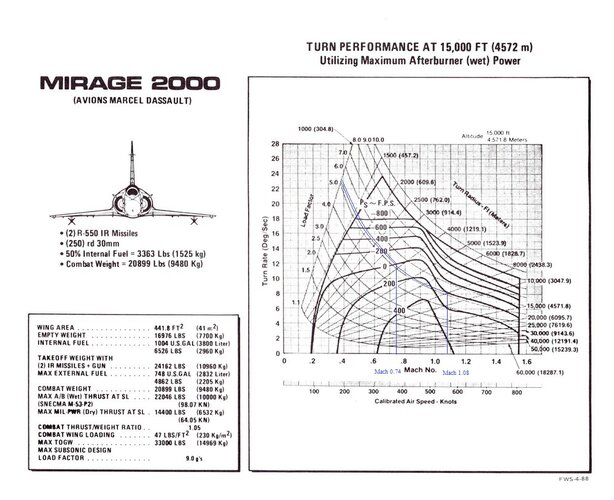
Israelis got about a third of their kills with missiles by the Yom Kippur War -- mostly the AIM-9D, with some G's delivered late. You're also overlooking the fact that even a missile which misses a substantial percentage of the time like the Great White Hope causes the MiG to evade-- which wrecks havoc on formation discipline, energy management, situational awareness, etc -- all of which contribute to circumstances making those gun kills easier to come by.
With Phantoms, from 1969 onwards and accelerating after 1974 when the Mirages III-CJ grew too old and scored their last kills.
Not Mirage III-CJ, which stuck to their guns (lame pun assumed) until their last victories in March 1974.
Mirages could carry AIM-9B and early Israeli AAMs (Yahalom and Shaffrir 1) which did not worked very well... Nesher were not much better, as shown in the Falklands later.
It took Kfir C1 and C2 for Israeli deltas to get good enough radar and missiles...
Last edited:
Similar threads
-
-
English Electric Lightning - Genesis and Projects by Tony Wilson
- Started by Schneiderman
- Replies: 15
-
Speculative Mirage III upgrade path for a fictitious nation
- Started by Blackscorpy
- Replies: 18
-
-
Spanish Mirage III EE/ED (C.15) upgrade program
- Started by NoBarrelRolls
- Replies: 10

